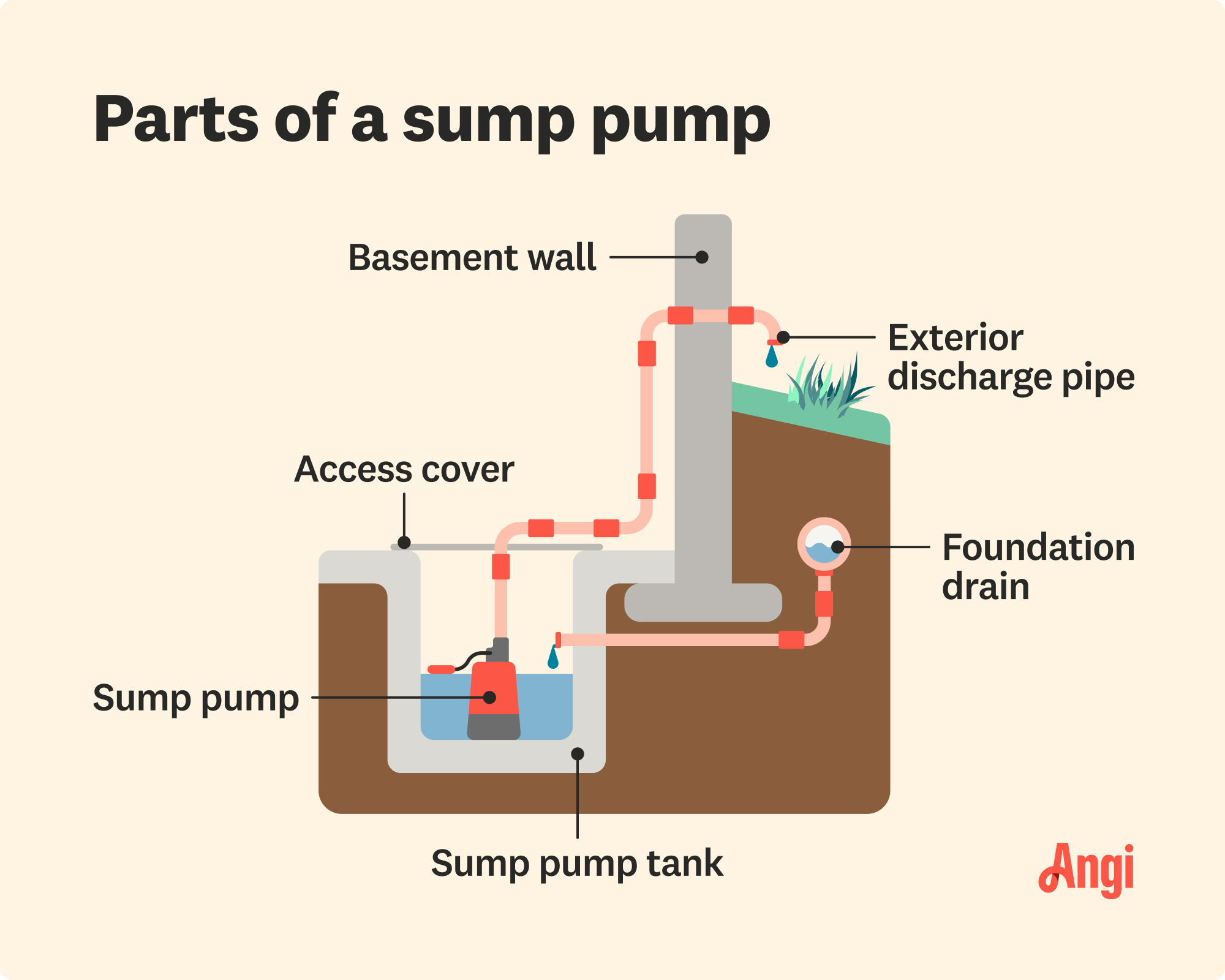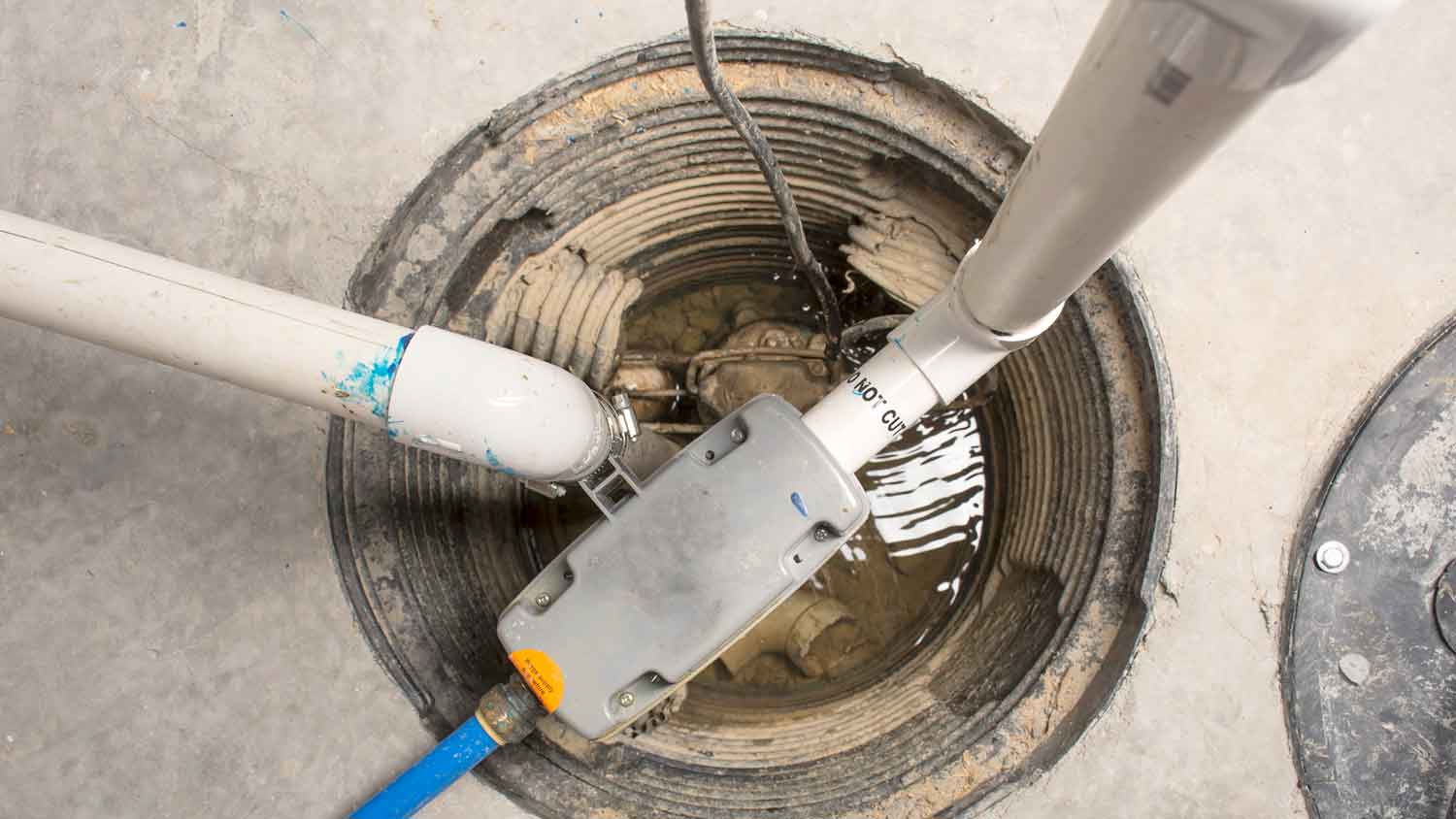
Emergency plumbers cost between 1.5 and 3 times as much as a typical plumber. Get specifics for your plumbing issue and city in our guide.
Stay dry with this handy guide


Sump pumps can prevent flooding and water damage.
There are two primary sump pump types: submersible and pedestal.
Battery- and water-powered sump pumps are secondary options that can serve as backups to your primary sump pump.
A sump pump is a worthy investment for many households, particularly those in flood-prone areas. These devices can help protect your home against flooding and water damage and prevent sewage backups. This guide breaks down everything you need to know to find the right sump pump for your home, including different types and costs.
Sump pumps remove excess water from a sump pit, the lowest part of a basement or crawl space designed to collect water. They are essential devices in areas prone to flooding or where the water table is above a home’s foundation.
By removing excess water, sump pumps help prevent water damage and the growth of mildew and mold. If you don't have a line that pushes sewage out to a drainage system, sump pumps can also remove sewage from a lower area of your home.


Sump pumps are installed in the lowest part of a basement or crawlspace in a sump pit. When enough water flows into this pit via drains or natural water migration through the soil, the sump pump turns on and removes water from the pit, expelling it through a discharge pipe. The pipe then directs the water away from a home’s foundation, often into a storm drain or dry well.
Sump pumps bring many benefits, especially to folks who live in flood-prone areas. Here are some ways that sump pumps can benefit your home.
One of the main benefits of a sump pump is its ability to prevent flooding in your home. Since they automatically remove accumulations of water from the sump pit, they can keep water levels under control, preventing water from spilling over and flooding the basement or crawlspace. Just keep in mind that the sound of your sump pump alarm going off is your system's way of letting you know that an issue is preventing it from keeping up with the rate of water flowing into your basement.
What is Brown Friday? Unfortunately, some holidays when bathrooms get heavy traffic leave homes vulnerable to serious sewage backups. Sump pumps can also protect against sewage backups. They’re particularly helpful in areas with combined water and sewage systems. Heavy precipitation can overwhelm these systems and create a reverse flow of sewage water, but a sump pump can help to prevent this backward sewage flow from reaching the interior of your home.
Since sump pumps help to keep basements and crawlspaces dry, they can reduce mold and mildew, which thrive in moist environments. Not only can mold and mildew damage building materials and your belongings, but they can also cause health issues, like allergies and respiratory problems, so having a sump pump can help you keep these issues at bay.
Persistent moisture can damage the structural integrity of a home’s foundation, leading to problems like cracking, sinking, and shifting. Since sump pumps prevent water from accumulating, they can help to protect your foundation from these problems.
There are several different types of sump pumps. Here’s a breakdown of each main type to help you find the best option for your needs.
Submersible sump pumps are typically placed in a sump pit and covered by water. They’re quieter than other types since the water helps to reduce noise. Being underwater can also help keep the motor cool, potentially prolonging the pump’s life span. However, they’re usually more expensive than other types of pumps.
Unlike submersible sump pumps, pedestal sump pumps have motors that sit above the sump pit, so they’re not submerged in water. This design keeps the motor dry and more easily accessible for sump pump maintenance and repairs compared to submersible pumps. These pumps are more affordable than submersible pumps, but they’re also noisier and may have a shorter life span.
Battery backup sump pumps are secondary pumps that automatically kick in if your primary sump pump fails due to a power outage or mechanical failure. They can provide added peace of mind during storms, helping to prevent flooding even when your power goes out.
Water-powered sump pumps do not require electricity to operate; instead, they use the pressure from the water supply line to create a vacuum that draws water out of the sump pit. Like battery sump pumps, water-powered pumps are typically used as a backup to the primary pump because they usually have lower pumping capacities compared to electric sump pumps. They also use quite a bit of water.
In addition to different types of sump pumps, there are also different types of sump pump switches. These switches primarily differ by their working mechanism.
Tethered float switches comprise a floating ball with a tether attached to the activation mechanism of the sump pump. The ball sits in the sump pit, and as water fills it, the float rises, stretching the tether, then triggers the pump to start.
Vertical switches comprise a float that slides up and down a vertical rod when water levels change in the sump pit. Once the float rises to a certain height on the rod, it triggers the pump to turn on. The vertical design of these switches makes them more compact than some other switches, so they’re a nice option for smaller sump pits.
Electronic switches use a sensor for sump pump activation. The sensors are designed to detect water levels and activate the pump when water gets too high. Unlike tethered and vertical switches, electronic switches don’t have moving parts involved in pump activation, which reduces the risk of mechanical failures compared to float-based systems. Electronic sensors also tend to offer more precise control over the pump’s operation, but they’re typically more expensive than other types.
Diaphragm switches employ pressure-sensing membranes, aka diaphragms, that sense water pressure changes as the water level rises. The diaphragm is connected to the pump’s electrical switch, so once the water fills and stretches the diaphragm to a certain point, it switches the pump on. These switches are highly sensitive to water pressure, so they can react quickly to water level changes.

Sump pumps are more beneficial for some households than others. For instance, if you live in a very dry area, it might not be worth the investment, particularly when compared to folks who live in flood-prone regions.
If you have a finished basement that you use as an additional living space, a sump pump is a worthy investment since water damage to these spaces can be highly disruptive and more expensive than it is in an unfinished basement. People usually have furniture, electronics, and other belongings in finished basements, which will cost more to replace.
People who live in flood-prone areas benefit most from sump pumps. The pump acts as a first line of defense against flooding, removing excess water as it fills the sump pit and preventing it from flooding their homes.
Similarly, homes in areas with high water tables also benefit from sump pumps since the water under the soil is closer to the foundation of a home than it is in areas with lower water tables. This higher level makes homes more susceptible to water damage, which a sump pump can help to protect it from.
It’s not just rain that can lead to water damage and flooding in the home. If you live in a cold climate that sees lots of snow, a sump pump can help minimize the water accumulation that occurs as the snow melts, protecting your home from damage.
Sometimes, a home’s surrounding landscape and/or soil type doesn’t allow for effective rainwater drainage. For instance, soils with high clay content don’t absorb water very well, which can lead to water pooling near or under the house. A sump pump can help to remove excess water in these instances.
A sump pump is one of the best defenses against moisture-related damage you can add to a home. From reducing mold and fungal growth to protecting your foundation and keeping the basement dry, a sump pump can reduce many of the major headaches homeowners face in the battle against water damage. However, not every home needs a sump pump. While a sump pump is always recommended for a home with a basement, you have to decide based on your risk of groundwater intrusion. Here are the scenarios when a sump pump is necessary.
Low-lying properties, coastal properties, creek-side and riverside properties, or any property in a flood-prone zone needs a sump pump. If your home is situated between hills, you may also experience runoff and high groundwater levels during rainstorms or snowstorms. Additionally, homes that are built in neighborhoods on top of filled-in swamplands or marshes often require sump pumps.
A sump pump is highly recommended if your basement has ever flooded before. Don't assume that a bad storm surge that flooded your basement in the past was a once-in-a-lifetime event. If you've purchased a home, ask a professional to tell you if there's a chance the basement has been flooded before based on telltale signs.
Consider adding French drains or a new gutter system to direct water away from your home's foundation before it has a chance to enter your basement. However, these options work best in conjunction with sump pumps. Many homeowners who know that their homes attract moisture also keep manual hand pumps in their basements for times when they need to expel water.
Sump pump costs vary by size, location, and type, but it usually costs between $1,200 and $2,500 to professionally install a sump pump. Submersible sump pumps usually cost the most, at around $100 to $400, not including labor, followed by pedestal pumps, which usually cost between $60 and $170 per unit. Labor can add quite a bit to the cost, with most pros charging anywhere from $45 to $200 per hour for several hours of work.
From average costs to expert advice, get all the answers you need to get your job done.

Emergency plumbers cost between 1.5 and 3 times as much as a typical plumber. Get specifics for your plumbing issue and city in our guide.

Wondering how much it costs to reroute plumbing? We have the information you need to learn about plumbing vent pipes and cost considerations when installing them.

The cost to replace cast iron pipes depends on many factors, like size and accessibility. Use this guide to get a rough idea of how much you’ll spend.

Copper is prone to leaks from corrosion, particularly pinhole leaks. This guide will show you how to fix a copper pipe leak in seven different ways.

Touchless faucets offer benefits like saving water, avoiding germs, and simplifying cleanup. Learn the top benefits of hands-free faucets and decide whether to switch.

Accidents can cause your sewer pipe cap to break. While fixing it is essential, don’t jump right in. This guide will prepare you with must-know tips.